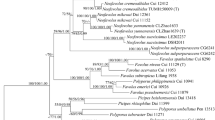Abstract
Rhodotus has been regarded as a monotypic genus, consisting of only one species, R. palmatus, for a long time. Morphological and phylogenetic studies were carried out on collections of Rhodotus from temperate, subtropical and tropical China. Our phylogenetic analysis of DNA sequences of three loci (the internal transcribed spacer, the large subunit nuclear ribosomal RNA, and the translation elongation factor-1 alpha) revealed that there are two phylogenetic species in the northern hemisphere, which is in concordance with morphological traits, supporting the division of Rhodotus into two distinct species. Rhodotus asperior is described as a new species that differs phenotypically from R. palmatus in its broadly ellipsoid to subglobose, more roughened basidiospores, longer cheilocystidia with slightly thickened wall, and its occurrence in tropical and subtropical environments. The discovery of this new taxon indicates Rhodotus has a wider distribution than previously thought.






Similar content being viewed by others
References
Binder M, Hibbett DS, Wang Z, Farnham WF (2006) Evolutionary relationships of Mycaureola diseae (Agaricales), a basidiomycete pathogen of a subtidal rhodophyte. Am J Bot 93:547–556
Bulliard P (1785) Herbier de la France, Paris
Doyle JJ, Doyle JL (1987) A rapid DNA isolation procedure for small quantities of fresh leaf material. Phytochem Bull 19:11–15
ECCF (European Council for the Conservation of Fungi) (2005) Country reports for the period 2000–2005:1–47
Edgar RC (2004) Muscle: multiple sequence alignment with high accuracy and high throughput. Nucleic Acids Res 32:1792–1797
Hall TA (1999) BioEdit: a user-friendly biological sequence alignment editor and analyses program for windows 95/98/NT. Nucleic Acids Symp Ser 41:95–98
Han SK, Park YJ, Choi SK, Lee JO, Choi JH, Sung JM (2006) Some unrecorded higher fungi of the Seoraksan and Odaesan National Parks. Mycobiology 34:56–60
He X (1992) A new species and a new record of Tricholomataceae from China. Acta Mycol Sin 11:18–22 (In Chinese)
Horak E (1968) Synopsis generum agaricalium (Die Gattungstypen der Agaricales). Beitr Kryptog Schweiz 13:1–741
Imai S (1938) Studies on the Agaricaceae of Hokkaido II. J Fac Agric Hokkaido Imp Univ Sapporo 43:179–378
Kornerup A, Wanscher JH (1981) Taschenlexikon der Farben, 3rd edn. Muster-Schmidt Verlag, Göttingen
Krieglsteiner GJ (1979) Über einige Neufunde von Asco- und Basidiomycetes in der Bundesrepublik Deutschland. Z Mykol 45:35–44
Kühner R, Romagnesi H (1984) Flore analytique des champignons supérieurs (4th printing). Masson, Paris
Maire R (1926) Études mycologiques, fasc. 2. Bull Soc Mycol Fr 40:293–317
Moncalvo JM, Vilgalys R, Redhead SA et al (2002) One hundred and seventeen clades of euagarics. Mol Phylogenet Evol 23:357–400
Mueller GM (1992) Systematics of Laccaria (Agaricales) in the continental United States and Canada, with discussion on extralimital taxa and descriptions of extant types. Fieldiana Bot 30:1–158
Noordeloos ME (1995) Tribus Rhodoteae. In: Bas C, Kuyper TH W, Noordeloos ME, Vellinga EC (eds) Flora agaricina neerlandica, vol 3. Balkema, Tokyo, pp 175–176
Pegler DN, Young TWK (1975) Basidiospore form in the British species of Clitopilus, Rhodocybe and Rhodotus. Kew Bull 30:19–32
Pouchet MA (1932) Considérations sur Rhodotus palmatus (Bull., Fries) R. Maire, et sur ses variations. Bull Soc Mycol Fr 48:76–83
Redhead SA (1989) A biogeographical overview of the Canadian mushroom flora. Can J Bot 67:3003–3062
Rehner SA (2001) Primers for elongation factor 1-α (EF1-α). http://www.aftol.org/pdfs/EF1primer.pdf
Rehner SA, Buckley E (2005) A Beauveria phylogeny inferred from nuclear ITS and EF1-sequences: evidence for cryptic diversification and links to Cordyceps teleomorphs. Mycologia 97:84–98
Ripkova S (2003) New, rare and less known macromycetes in Slovakia I. Czech Mycol 55:187–200
Ronquist F, Huelsenbeck JP (2003) MrBayes 3: Bayesian phylogenetic inference under mixed models. Bioinformatics 19:1572–166574
Sundberg WJ, Methven AS, Monoson HL (1997) Rhodotus palmatus (Basidiomycetes, Agaricales, Tricholomataceae) in Illinois. Mycotaxon 65:403–410
Swofford DL (2004) PAUP*. Phylogenetic analysis using parsimony (* and other methods), Version 4.01. Sinauer, Sunderland
Taylor JW, Jacobson DJ, Kroken S, Kasuga T, Geiser DM, Hibbett DS, Fisher MC (2000) Phylogenetic species recognition and species concepts in fungi. Fungal Genet Biol 31:21–32
Thiers B [continuously updated]. Index Herbariorum: A global directory of public herbaria and associated staff. New York Botanical Garden’s Virtual Herbarium. http://sweetgum.nybg.org/ih/
Tolgor B, Fan YG (2008) Study on domestication of Rhodotus palmatus. Edible Fungi China 27(5):16–18
Vilgalys R, Hester M (1990) Rapid genetic identification and mapping of enzymatically amplified ribosomal DNA from several Cryptococcus species. J Bacteriol 172:4238–4246
Wang B, Zhang MJ (1992) New record of Rhodotus palmatus from China. Microbiology 19:72 (In Chinese)
Wang L, Yang ZL, Liu JH (2004) Two new species of Laccaria (Basidiomycetes) from China. Nova Hedwig 79:511–517
White TJ, Bruns T, Lee S, Taylor J (1990) Amplification and direct sequencing of fungal ribosomal RNA genes for phylogenies. In: Innis MA, Gelfand DH, Sninsky JJ, White TJ (eds) PCR protocols: A guide to methods and applications. Academic, San Diego, pp 315–322
Acknowledgments
The authors are very grateful to the following people: Dr. J. Borovička, Department of Nuclear Spectroscopy, Nuclear Physics Institute, the Academy of Sciences of the Czech Republic, for sending us a collection of R. palmatus; Dr. E. Horak, Innsbruck, Austria, for giving us good suggestion for the line-drawings; Dr. R.J. Vilgalys, Duke University, USA, for supplying accurate information about the GenBank sequence of the North American R. palmatus; Dr. Y.C. Li, Kunming Institute of Botany (KIB), Chinese Academy of Sciences (CAS), for providing valuable images of R. asperior; Dr. Z.X Ren and Mr. G. Wu, KIB, for helping us in using the SEM facility. The authors thank Dr. Hong Luo (DOE-Plant Research Laboratory, Michigan State University, USA) for polishing the English. This work was supported by the National Natural Science Foundation of China (No. 31170024), the Ministry of Science and Technology of China (2008FY110300), and the Knowledge Innovation Program of the CAS (No. KSCX2-EW-Z-9).
Author information
Authors and Affiliations
Corresponding author
Rights and permissions
About this article
Cite this article
Tang, LP., Hao, YJ., Cai, Q. et al. Morphological and molecular evidence for a new species of Rhodotus from tropical and subtropical Yunnan, China. Mycol Progress 13, 45–53 (2014). https://doi.org/10.1007/s11557-013-0890-x
Received:
Revised:
Accepted:
Published:
Issue Date:
DOI: https://doi.org/10.1007/s11557-013-0890-x




